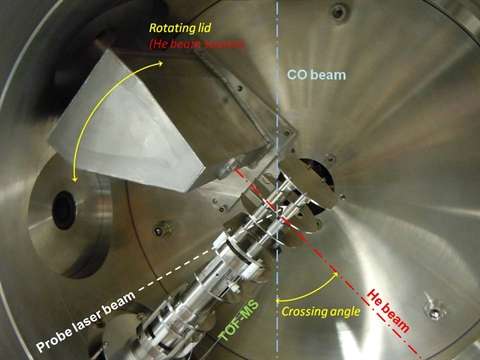Colliding helium and carbon monoxide particles don't have to drift apart

In a paper published on 24 March in Nature Chemistry, researchers from Nijmegen and Bordeaux showed under which special conditions carbon monoxide molecules and helium atoms do not fly apart immediately following a collision, but stay together for a while. The French setup that made this experiment possible, now has a much more accurate equivalent at Radboud University.
To understand what happens in interstellar gas clouds, low-speed collision experiments are conducted on Earth using very cold atoms and small molecules. The processes that take place in these environments can then be studied very precisely. CO is often used as a tracer to investigate the conditions in interstellar clouds by spectral measurements. Detailed knowledge on molecular collision processes enables astronomers to extract more information from such measurements.
Combination of theory and experiment
The researchers in Nijmegen theoretically predicted the effects of the collisions and their predictions were confirmed by experiments in the crossed molecular beam setup in Bordeaux. "It is wonderful that we are now able to predict so well what happens under which conditions," said Jolijn Onvlee, PhD candidate under both the theoretical chemists Emeritus Professor Ad van der Avoird and Professor Gerrit Groenenboom and the experimental physicist Dr Bas van de Meerakker of Radboud University. It is this particular combination of theory and experiment that the researchers believe is the reason that "we made it into Nature Chemistry".
Two states
They discovered two mechanisms by which the colliding particles could temporarily stay together. In one case, CO and He are orbiting around each other and the collision energy is transformed into centrifugal energy; in the other the CO molecule temporarily absorbs the collision energy by entering a higher rotational energy level. Such phenomena only take place in low-speed collisions at specific energies and they lead to a particularly efficient transfer of energy between the colliding particles.
Special experimental techniques are needed to study such slow collisions. These experiments have been performed at Bordeau, but by now Radboud University has a setup where colliding molecules can be studied in even more detail.
The results of this work and other studies performed by the group of Groenenboom and Van der Avoird are much wanted by astrophysicists in the universities of Groningen and Leiden and the research institute for radio astronomy in Dwingeloo, as well as elsewhere.
More information: "Quantum dynamical resonances in low-energy CO(j = 0) + He inelastic collisions." Nature Chemistry 7, 349–353 (2015) DOI: 10.1038/nchem.2204
Journal information: Nature Chemistry
Provided by Radboud University




















